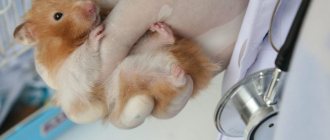Causes of baldness
Without examination, no veterinarian, even the most experienced, can give a definite answer to the question of why a hamster is going bald. Since there may be several reasons for this phenomenon, namely:
- allergic reaction to cage bedding;
- suffered stress;
- lack of vitamins and minerals or their excess in the rodent’s body;
- food poisoning caused by ingestion of pesticides;
- fungal infections;
- skin diseases and the presence of subcutaneous parasites.
It is worth noting that any breed of rodents of the Hamyakov family is prone to baldness.
Hormonal changes in females
Females nursing their young have bald patches on the abdomen, in the area of the mammary glands. The fur grows back after the mother stops feeding her milk to the hamsters. While bearing offspring, a pregnant female may lose fur intensively.
Separately living females may have reproductive diseases that lead to baldness. They may have polycystic ovary syndrome, inflammation of the uterus. In this case, hormonal alopecia is observed in the form of symmetrical bald spots along the sides. At the same time, hamsters do not itch.
Diagnostics
The most common cause of baldness in domestic hamsters is infection with lichen. Moreover, it is not always possible to determine the presence of lichen in a hamster at the initial stage. Baldness caused by lichen appears first on the back, then on other parts of the body. In areas of baldness, you can notice small scales and wounds from scratching. If an animal constantly scratches due to unbearable itching, it most likely has lichen.
Article on the topic: What to do if your hamster falls from a height or from a table
Treatment of a hamster that has become bald from lichen is carried out using special ointments. But you shouldn’t get carried away with self-medication. After all, in nature there are many varieties of lichen. Each case requires individual and well-chosen treatment.
The second reason, which is often accompanied by baldness of a domestic hamster, is an overabundance or lack of vitamins. You shouldn’t stuff your animal with everything in order to get rid of this problem. First you need to establish the cause. For this purpose, the veterinarian conducts an in-depth diagnosis of the pet:
- take a skin scraping;
- will inspect the affected areas under a special lamp.
A comprehensive diagnosis will help determine the cause of baldness, after which a specialist will prescribe the necessary treatment for your animal.
Demodicosis
It is caused by the Demodex Aurati mite. The parasite's habitat is under the skin. With this disease, the animal goes bald, and crusts appear in places where there is no hair. The chest and lumbar region are mainly affected. Demodecosis becomes a consequence of a weakened immune system. This disease can be diagnosed by making a scraping. Treatment is determined by a veterinarian.
First aid
Finding out the causes of baldness
It is not always possible to seek help from a specialist. After all, not every locality has a veterinary clinic. What to do in this case? If your hamster is going bald, you will have to take remedial measures yourself. The causes of hamster baldness should be excluded and checked gradually and in order.
Filler
This is the first thing you need to pay attention to. There are many good and not so good fillers. Some of them can cause an allergic reaction in a pet and the development of infectious diseases. Whatever the filling in the cage, at the moment when the animal itches and loses hair, it must be completely removed.
But leaving your hamster without any flooring is also not a good idea. The best material in this case would be paper. You can use napkins or toilet paper. The main condition is that such material must be white, without any inscriptions or images, as well as without flavors or dyes.
Cell disinfection
Clear the rodent's home of all objects with a porous structure - stones, twigs, etc. Carry out a general cleaning of the cage with disinfectants. You can only use a weak solution of potassium permanganate or soda solution.
Article on the topic: Colds and runny nose in a hamster: causes and treatment at home
Thoroughly rinse all the equipment - the wheel, drinking bowl, feeders and other accessories that are available in the rodent's house.
Diet correction
During the period when the Dzungarian, Syrian or other species of the Hamyakov family goes bald, great importance should be given to its nutrition. After all, food is one of the main sources of allergic manifestations, as a result of which the hamster becomes bald.
Wet food should be excluded from the diet, and first of all, fruits and vegetables. At the time of treatment of the disease, limit yourself to dry food.
Also, don’t forget about drinking. The water in the drinking bowl should always be clean and fresh.
Eliminate stressful situations
Some breeders believe that moving or relocating hamsters to another place does not in any way affect the condition and health of the pet. And they are deeply mistaken. This rodent, like any other pet, reacts poorly to changes in environment. And if this happens systematically, he becomes bald.
Also, do not forget that this mammal prefers a solitary life. The proximity of relatives can be a great shock for him, and as a result, the cause of baldness.
Age-related changes
When buying a particular breed of pet rodent, ask how many years it has lived at home. This is very important, because by the time an old hamster reaches this age, it begins to have health problems, and this often manifests itself through baldness of the skin.
Age
A natural phenomenon is hair loss in old hamsters. Your pet has been living with you for more than two years; it has no skin diseases, but its fur is thinning. The reason lies in the fact that hamsters, on average, live three years.
One year for a hamster is like our twenty-five years. Some people start going bald after thirty. A two-year-old hamster is like a fifty-year-old man. Your beloved furry pet is just getting old. And, sad as it may be, the fur thins out only due to the hamster’s advanced age.
This is the case when your pet's fur loss is not a concern. Your task is to care for your hamster so that he comfortably lives out his hamster life.
Shedding
A complete or partial change of coat is called molting. It has two varieties:
- Age - young animals develop denser hair instead of a soft fur coat. The process usually occurs unnoticed by the owner, at the age of about four months.
- Seasonal – associated with the seasons. Spring and autumn molting are most typical for animals. If they hibernate in winter, they shed their fur in summer.
Regarding hamsters, it is impossible to say for sure whether they shed. Of course, the fur is renewed, and if the rodent is healthy, its owner does not even notice it. But in many ways this process depends on hereditary factors and conditions of detention.
If the hamster is healthy, then fur renewal is a completely natural process.
If your pet is losing hair, keep an eye on him. Is he active, eating well and not itchy? Most likely it's molting. If you wish, you can do a visual test - blow on the fur and carefully examine the hair. For example, in Djungarian hamsters it has three colors, and when the fur is renewed, their number increases to six.
Prevention
The disease is easier to prevent than to treat. With regard to skin diseases in rodents, the following measures must first be observed:
- do not approach the hamster in street clothes and shoes;
- handle your pet with washed hands;
- follow quarantine rules after acquiring a new animal;
- maintain the animal’s home in good sanitary condition;
- protect your pet from stressful situations.
If trouble happens and the pet dies from skin problems, then before purchasing a new hamster you need to do a general cleaning of the room and thoroughly disinfect all equipment and the cage.
The health of pets depends on the owner
Inattention and negligence can destroy even such an unpretentious creature as a hamster
Why does a hamster go bald?
To help your pet and quickly solve the problem, it is important to determine the causes of baldness. It could be:
- allergies to food or sawdust;
- deficiency or excess of vitamins;
- poisoning;
- parasites;
- stress.
First of all, you need to find out the cause of hair loss.
Most often, hair loss occurs due to an unbalanced diet, the presence of ticks or other parasites. For an accurate diagnosis, you should contact your veterinarian. He will carefully examine the animal and take a skin scraping. Based on the test results, a diagnosis is made and, if necessary, treatment is prescribed. Bald spots can be observed on different parts of the body, but most often it is the stomach and hind legs. If the animal has bare skin, additional dandruff, peeling, and scabs have appeared - this is a clear symptom of disease.
Article on the topic: Rabies in hamsters - one hundred percent fatal, signs and symptoms of the disease
What to do
If changing the bedding, good care and a nutritious diet have not stopped the hamster’s hair loss, then a visit to the veterinary clinic is essential. Unfortunately, not all doctors undertake to treat rodents.
Try to find a blade that has a specialist - a ratologist.
If there is no such hospital, the Internet will come to the rescue. Post good photographs of your pet on specialized veterinary websites, describe the problem in detail and get qualified advice.
The most common causes of baldness
If your pet is experiencing hair loss and you have been able to figure out why it is happening, you should quickly eliminate the source of the irritation and evaluate the results. When hair loss begins when changing bedding or other items in the cage, the situation can be corrected without serious consequences. If you fed your hamster a new product or low-quality food, normalize the diet and make sure that the food is always fresh. If there are no allergens on the menu, hair will stop falling out. These are all simple cases that do not require specialist intervention. But there are also more serious reasons, sometimes even life-threatening.
Poor nutrition
When the cause of the disease is the rodent's diet, the diet should be adjusted to eliminate it. In some cases, the veterinarian may recommend a dietary menu. As a rule, it involves eating a lot of greens and all kinds of nutritional supplements. Provided timely diagnosis and treatment, the situation normalizes within a month. The first signs of recovery can be observed within a week. The symptoms of the disease disappear, and the bald areas begin to be covered with new fluff. If baldness is caused by poisoning, exclude fresh vegetables and fruits from the menu. During this period, you can feed the rodent only high-quality dry food. Be sure to give your pet clean water.
One of the reasons for hamster baldness may be improper nutrition.
Fungi and viruses
Such diseases are accompanied by peeling skin and hair loss. When an infection is detected, rodents are prescribed specialized ointments - these can be found at a veterinary clinic or pharmacy. The product must be regularly applied to damaged areas until all signs of baldness disappear completely. For better results and prevention, you can use the ointment for some time after your pet has recovered.
Allergy
The cause of an allergic reaction is not easy to identify. Therefore, it is important to remember everything that preceded the disease. You may have bought new litter or toys, or changed your diet. If you have improved the cage, return it to its previous condition and be sure to wash it, preferably with a disinfectant, to eliminate residual reactions. Do not use chlorine under any circumstances - it is dangerous for the animal. It is best to buy a suitable product at a pet store and use it strictly according to the instructions. It is also possible to use household chemicals. Prepare a solution and immerse all objects that the hamster has come into contact with. After a few hours, rinse them thoroughly with water. Review your rodent's daily menu. To eliminate food poisoning, you can temporarily switch him to dry food.
Article on the topic: What to do if the hamster lies and does not move, but breathes
Stress
If your hamster's hair is falling out, but no apparent reason for this process has been identified, it is possible that the problem is related to stress. In this case, provide your pet with complete peace: place the cage in a quiet place, protect the animal from loud and sharp sounds. Allow him to fully rest, and the situation will quickly return to normal.
Any event can cause stress for small hamsters: moving, changing the situation in the cage, the appearance of new pets, new dishes in the usual diet, etc. To protect your pet from the effects of negative factors, surround it with care and attention.
Stress for a hamster can come from moving, changing the environment in the cage, or having new pets.
Old age
Hamsters age quite quickly: the first signs of imminent death appear at the age of two years. Among them is hair loss. In such a situation, there is nothing you can do to help your pet. Try to pay more attention to him and give him his favorite treats more often to make the last days of his life cozy and comfortable. The average life expectancy of hamsters is shown in the table:
Stressful situation
When stressed, hamsters work hard with their scent glands and, due to this intensity, begin to lose their thick fur. Hamsters are loners, leading an active nocturnal lifestyle. Intrusive imposition of your attention, changing rhythms with interruption of sleep during the day, loud screams of people, sounds of audio systems can bring severe discomfort to your pets.
Perhaps you have moved, or just bought your pet. Give him time to adapt so that he understands that there is nothing in danger for him here. Don't pick him up for a while. Let him get used to it.
Possible diseases
One of the most dangerous causes of baldness is disease.
Unfortunately, hamsters are susceptible to a wide variety of ailments. Among the most common are:
- Scabies is a disease where mites infest the skin of the animal. If they are not detected in time, the rodent may lose almost all its fur. The skin becomes inflamed, with traces of scratching. The animal suffers from itching and pain, behaves aggressively and is not allowed to be handled. Treatment aimed at destroying subcutaneous mites will help cope with baldness.
- Ringworm - it is accompanied by peeling of the skin, itching and usually has a chronic form. The hamster quickly becomes bald and itchy, but the bare areas have a regular rounded shape. They are covered with a crust, and the hair appears to be broken off at the root. Treatment of lichen is a long process that involves regular use of antifungal ointments and sprays.
- An abscess is a purulent inflammation of the skin. In this case, not only baldness is observed, but also a change in its color. The abscess opens spontaneously or in a veterinary clinic. When the inflammation is cured, the fur will grow back.
- Irritation from urine - if baldness appears on the hind legs and tummy, the skin is constantly in contact with urine. This is facilitated by a rare change of bedding and a small cage. If the conditions of detention are optimal, hair loss indicates that the animal drinks a lot and pees. This phenomenon is a symptom of diseases such as cystitis, urolithiasis, and kidney failure.
- Mechanical abrasion of fur - keeping a pet in inappropriate conditions can lead to fur loss due to constant external influence. This way, the hair on the paws and tummy is wiped off, but more often the problem is observed on the head, especially if the hamster likes to chew on the bars of the cage. If it is not possible to relocate the rodent, provide it with another object for grinding down its teeth - twigs, hard sticks, mineral stone.
- Hormonal changes – baldness can be caused by disruptions in the hormonal system. Hamsters have polycystic disease and ovarian tumors, endometritis, and inflammation of the uterus. Hair loss is also possible during pregnancy, and during lactation the female's belly becomes completely bare.
- Digestive disorders - if a hamster is poisoned, for some time its fur will not be as thick and shiny as before. This is due to the fact that nutrients are not absorbed and the body weakens. Poisoning from poor quality food is possible. When intoxicated, one of the symptoms is hair loss.
- Dental problems – if the growing teeth do not grind down and the incisors break, the rodent will not be able to eat normally. In addition, increased salivation occurs, which is why the hair on the neck will be wet all the time and will soon begin to fall out.
Article on the topic: How to euthanize a hamster at home, euthanasia under anesthesia
If any alarming symptoms appear, you should take your pet to the veterinarian. Only a specialist can identify the cause of baldness and make an accurate diagnosis. He must prescribe medications, since it is very difficult to calculate the dosage for hamsters. The doctor, taking into account all the characteristics of the animal, will select suitable drops or specialized shampoos.
Cystitis
Inflammation of the bladder or cystitis often occurs from hypothermia. Rodents do not have good thermoregulation, so even an ordinary draft can provoke it.
The most important rule is to protect your pet from hypothermia:
- hide it from the fan and open windows;
- remember its sensitivity to temperature changes;
- protect from drafts.
Simple rules, but how many difficulties can be avoided by simply closing the window in time! With cystitis, a hamster experiences a burning sensation when urinating and constant pain in the lower abdomen. He won’t be able to talk about it, but it’s possible to find out about the disease. As with colibacillosis, cystitis makes the hamster's fur wet. Losing fluid in such quantities can lead to dehydration.
It is because of the similarity of symptoms that you need to seek a final diagnosis from a specialist. If you suspect inflammation of the bladder, you should immediately go to a veterinary hospital, where they will tell you exactly what happened to your pet. Typically, for cystitis, your veterinarian will prescribe antibiotic treatment. To prevent this, it is better to take care of your pet’s health in advance.
How to prevent baldness
To avoid possible hair loss, provide your pet with comfortable living conditions. Protect him from stress, offer toys for an active lifestyle. Keep the cage clean - wash it regularly and change the bedding. A correct and balanced diet is very important: only high-quality products should be on the menu, periodically give the animal vitamins, but do not overdo it. If you surround your hamster with love and care, he will feel great and delight you with his health and good mood.
Allergy
Allergies can be food or contact. A food problem occurs when improper feeding occurs, when the hamster receives food “from the table” - sweet food, nuts, strawberries and other exotic delicacies. Contact – for household chemicals, filler (coniferous sawdust). If the animal sits in the owner's arms, it may be allergic to perfume.
When allergies occur, not only the animal’s skin is affected - the ears turn red, transparent discharge appears from the eyes and nose, and the animal may sneeze.
Treatment does not require the use of antihistamines; it is enough to identify and remove the cause. The bedding is replaced with white paper napkins, and all excesses are removed from the diet.
Scab
The causative agent is the fungus Achorion Schoenleini. Hamsters get the disease through contact with sick animals or humans, through insect bites and contaminated equipment.
It looks different depending on the stage of development.
Main symptoms:
- white scaly plaque on the ears, eyebrows and tip of the nose;
- formations are round in shape with a diameter of up to 1 cm;
- Over time, the affected areas become covered with blisters, which gradually increase in size and form crusts with hairs in the middle.
A sick animal must be isolated from other pets, the room and objects with which it has been in contact must be treated with disinfectants.
Establishing an accurate diagnosis will allow the veterinarian to select an antifungal drug, establish the dosage and course of treatment. It is also necessary to treat the affected areas of the skin - scales and scabs should be softened with oils and carefully removed.
Treat areas cleaned of crusts daily with iodine tincture mixed with alcohol solutions of glycerin, creolin or Lysol.
How can I help my fluffy?
The main thing is to pay attention to the itching animal in time. Of course, it will not be possible to diagnose the disease on your own. The first thing you need to do is isolate the itching hamster. The veterinary clinic must take skin scrapings from your pet, possibly fragments of fur, and use them to determine the presence of a particular parasite. If there are no parasites, the hamster may be suspected of having an allergy.
A veterinarian must prescribe drug treatment for a hamster, because due to its miniature size, the animal needs minimal doses of medication, which is not always possible to calculate independently. Stronghold drops are excellent for killing ticks. To get rid of fungus, bathing in special shampoos and treatment with antifungal ointments are suitable. It is imperative to disinfect the cage to destroy tick and flea eggs or fungal spores.
mymylife.ru
Lichen
This is a skin disease caused by a viral infection or microscopic fungi. Depending on the pathogen, there are two types of lichen: ringworm and pink lichen.
Rodents with weakened immune systems, mechanical trauma to the skin, and elderly animals are at risk of infection.
The following symptoms are typical for lichen:
- baldness;
- the appearance of inflamed areas;
- itching;
- loss of appetite.
If the disease is confirmed, the sick hamster is isolated from other pets, the cage, bowls, wheel and all objects that came into contact with the infected animal are disinfected. The most effective means for this will be a formaldehyde solution or a sulfur-carbolic mixture.
For treatment, antifungal drugs are used, which are prescribed by a specialist, who will also tell you the dosage and duration of the course. Hair is removed from damaged areas of the body as they are contaminated with fungal spores.
Dried crusts are softened and cut off, the area is treated with salicylic ointment, and the edges are treated with iodine. It is also recommended to support your pet’s body with immunostimulating drugs and probiotics during the treatment period.
Ringworm
A characteristic feature is rounded bald patches on the front of the body and muzzle.
Further, these bald spots become inflamed and form purulent ulcers, through which the fungus enters the body, poisoning it with toxins and causing itching throughout the body.
The disease is transmitted from humans to animals and vice versa.
Pityriasis rosea
The main difference from other skin diseases is the appearance of hairless pink areas of skin, more saturated at the edges than in the center.
It is not dangerous for humans - unlike trichophytosis (the scientific name for ringworm), it is not transmitted through household contact.
Fleas, lice, food eaters
Nowadays, a hamster with fleas and lice is a very rare occurrence. And yet, if your pet suffers such a fate, then the most effective method of combating these parasites is contact poison in the form of drops or sprays. Also, baths based on bromocyclene (5 percent solution) have proven themselves well as therapeutic and preventive measures.
But before you bathe your pet in such “medicinal” water, you should familiarize yourself with the rules for bathing hamsters in regular water, because there are a lot of nuances and recommendations that can help you avoid dangerous situations.
Take care of your pets and be happy!
Ticks
Ectoparasites on a hamster are quite common, but they do not bother the animal, since their number is usually small.
For a clear clinical picture of the disease to appear, they must be accompanied by vitamin deficiencies, weakened immunity, or poor hygienic conditions.
Causes and symptoms. Rodents are most often affected by Demodex mites, which are the causative agents of demodicosis.
With this disease, the pet experiences itching, dandruff, increased hair loss, dry and irritated skin.
Hamsters are often parasitized by Notoedres mites, the causative agents of notoedrosis.
This pathology is characterized by severe itching, hair loss, and the formation of dry crusts and dandruff on the face, ears, cheeks and limbs.
To get rid of itching, animals itch, the skin is damaged, and this leads to infection.
Rodents become irritable, refuse food - the result is exhaustion, which can be fatal.
Another type of scabies is caused by the scabies mite Sarcoptes anacanthos. With sarcoptic mange, pets itch severely, damaging the skin and infecting the wounds.
Pustules form throughout the body, which turn into scabs and scabs.
Without timely and effective help, a small pet may die 3-4 weeks after the first symptoms appear.
To get rid of ticks, use local preparations in the form of powders, sprays, ointments, shampoos with selenium sulfide or oral insecticides. Diagnosis and treatment should be carried out by a veterinarian.
The drugs metrifonate and cythioate showed good results. For sarcoptic mange, infected animals are bathed in a 0.5% bromocyclene solution.
To cure a hamster from notoerdrosis, the affected areas should be treated with a 3% solution of the drug SK-9, sulfur ointment, the course of recovery is 7-10 days.
In case of bream, the pet must be isolated from other individuals, and the cage and objects with which it has been in contact must be disinfected. This will prevent re-infection.
Infectious skin diseases
Scabies
Most often, baldness in hamsters is caused by parasitism of subcutaneous mites. With advanced demodicosis, the animal loses up to 90% of its fur. The skin looks not just bare, it is inflamed, thickened, with traces of scratching. The hamster itches, squeals in pain, behaves aggressively, and does not allow you to pick it up.
Inexperienced owners believe that allergies are one of the most common reasons why hamsters go bald. By changing food and filler for a long time, they lose time, and demodicosis takes a generalized form. Allergies do occur in hamsters, but they are more often manifested by rhinitis and conjunctivitis than by skin problems.
When the Djungarian hamster goes bald, the veterinarian will begin treatment against the subcutaneous mite, even if the parasites could not be seen in the skin scraping. It is difficult to get a good scraping from a small, nimble rodent that cannot be properly fixed.
hamster scabies
Treatment: Otodectin (0.1% ivermectin) subcutaneously at intervals of 7-14 days, 2-4 injections, up to 6 times if the problem is advanced. Dose 0.2 ml per 1 kg of weight. The Syrian hamster weighs approximately 150 g; such an animal is given 0.03 ml of otodectin. Dzungarik weighs about 50 g, its dose is 0.01 ml.
Lichen
Fungal skin diseases are characterized by peeling of the skin, chronic course and itching. The hamster, as with demodicosis, becomes bald and itchy, but the hairless areas of a regular round shape are limited. The skin is not completely bare, covered with a crust, and the hair seems to be broken off at the root. Ringworm can be treated over a long period of time using antifungal ointments and sprays. Fortunately, it is rare.
hamster has lichen











